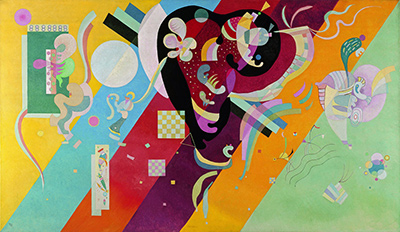Kandinsky believed every colour had its own story and mystery. Some of his most notable works are part of his composition collection.
There were 10 created in total, the first one painted in 1910 and the last in 1939. The first three were unfortunately destroyed during the Second World War and only images of them survive.
They all have similar characteristics including immense size, abstract form and transcendence through creation and are representative of Kandinsky's artistic theory. Kandinsky loved the idea of creating an abstract composition, which is most likely why they always reappear throughout his artistic career.
Composition IX is one of works in this collection. It is quite a large painting as it measures 113.5cm X 195cm. This would pose quite a spectacle if seen in real life.
It is currently held in the Centre Georges Pompidou in Paris, France. This painting was reportedly created from only one preliminary sketch. It was painted later in the artist's career when, according to Kandinsky's wife at the time, Nina, he would see the paintings in his head and put them on the canvas.
Kandinsky referred to this new era of his career as "a picturesque fairy tale". This period was characterized by a movement from the use of primary colours to more subtle and soft nuances of colour.
Referred to the "Great Synthesis", it supported and developed Kandinsky's theory that abstract art is part of a real world and as concrete as other types of art. He was also quite isolated at this time as he had an aversion to the public and felt like his abstract paintings were not appreciated and recognized by the public.
However, it is difficult to tell he is isolated in Composition IX because it is a bright, colourful painting full of happy shades and interesting, non-geometric shapes.
These interesting shapes are considered part of the biomorphic abstraction style. This refers to artistic designs that are reminiscent of nature and living organisms.
The wide diagonal lines in the background are the only kind of organization in this mesmerizing mixture of shapes. They mirror each other and serve as the basis for the other forms.
While abstract paintings are often up for interpretation based on what the viewer sees, there are interpretations that give meaning to the biomorphic forms.
A popular opinion is that the prominent red and black shape in the middle is reminiscent of a fetus in the womb. It is also reminiscent of a heart, as is the pale pink shape on the right side of the painting. There are also other smaller shapes that have similar forms as intestines or kidneys. Perhaps Kandinsky was thinking about life and birth as he was painting Composition IX.
Perhaps living through the First World War and seeing the beginning of the Second had him thinking of this as well. The fact that no exact meaning exists behind this painting is part of the beauty of abstract art and Kandinsky's intention with his creations.
Wassily Kandinsky was a Russian art theorist and painter. Born December 16, 1866, his interest in painting began at a young age as he found it lifted him out of his reality.




